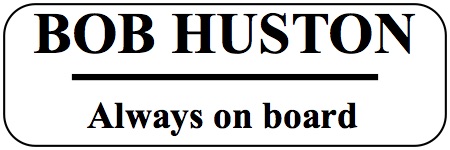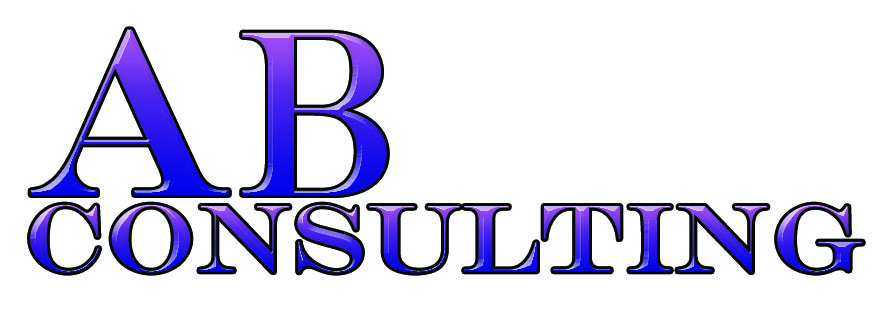DOGS
Dog mushing is a way of life and Alaskan huskies are the center of all the activities at the kennel. They are like any other ‘normal’ dog in that they need four basics: food, shelter, health attention, and personal care. But SP Kennel dogs require much more. As competitive athletic sled dogs they also require top nutrition, constant veterinary oversight, consistent fitness conditioning and mental coaching. They are athletes that compete at the highest level of racing and deserve the best.
A young SP Kennel pup grows up and trains alongside veteran racers from this kennel. The pups eventually step into the paw prints left by his or her parents and grandparents. Our goal is for all our pups to become dogs that will race. Every dog is at least given a chance, or several, to race. This is regardless of size, color, sex or whatever other human prescribed “flaw” a musher might deem important. And this works for us. The majority of our pups will eventually race the Yukon Quest and/ or the Iditarod (85% over the last 5 years). The remaining 15% have all raced mid distance races. They gave it their best shot, they just never made it to the “Superbowl”.
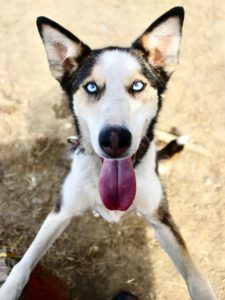 The main dog philosophy at SP Kennel is: a dog remembers everything. For that reason, we train and race our dogs with a completely positive approach. We want them to trust us completely – always. We show our dogs what we want them to do and then we teach them how to give it to us. This teaching might take some time, but we have plenty of time for all of our dogs.
The main dog philosophy at SP Kennel is: a dog remembers everything. For that reason, we train and race our dogs with a completely positive approach. We want them to trust us completely – always. We show our dogs what we want them to do and then we teach them how to give it to us. This teaching might take some time, but we have plenty of time for all of our dogs.
Of course, each SP Kennel dog is an individual with a different personality and traits. In order to perform to his or her best, the musher (or coach) must know every dog intimately. Who is bold and carefree? Who is timid? Who is slower or quirky? Who is a picky eater? Who gets stressed out at the start line? Who is too friendly among fans? And so on.
Our overall goal is two fold. SP Kennel puppies are bred, raised and trained to be:
- Forever loving, dedicated canine companions -and-
- Working sled dog team mates
One dog can be excellent at both.
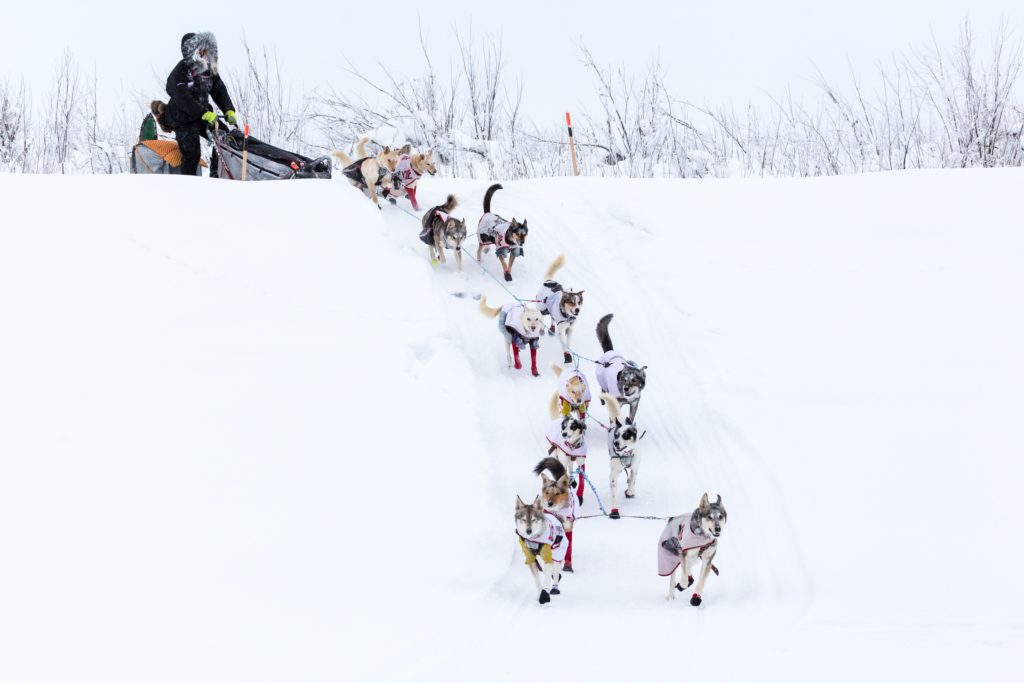
How do we do that?
SP Kennel Puppies are babies. They all learn at their own rate. Each pup needs to grow up before he or she is shown the basics of mushing. Those simple skills include: come when called, do not argue over food or attention, do not chew lines and collars and behave indoors as well as outdoors. Dog manners are of supreme importance and peaceful interaction between all dogs is highly stressed the first year of a puppies life. SP Kennel has a ‘no growling’ policy as well as a “Quiet!” command. Dog mushing is much more fun with happy, friendly dogs who are responsive.
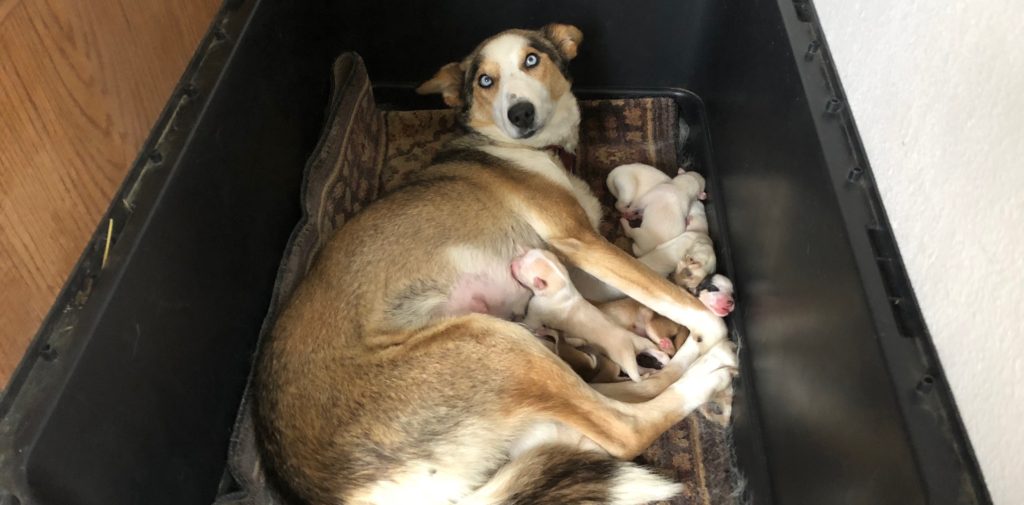
 At SP Kennel, pups are not put in harness until 8 to 12 months of age. Fortunately Alaskan huskies have an instinct to pull and run, so ‘teaching’ a pup to work in harness in front of a sled is easy. Each pup is partnered with a calm adult and “off we go” with a small, slow dog team. Nearly 100% of the puppies born and raised at SP Kennel take to a harness and begin pulling within their first 50 steps. Alaskan huskies love to run and pulling in harness comes naturally.
At SP Kennel, pups are not put in harness until 8 to 12 months of age. Fortunately Alaskan huskies have an instinct to pull and run, so ‘teaching’ a pup to work in harness in front of a sled is easy. Each pup is partnered with a calm adult and “off we go” with a small, slow dog team. Nearly 100% of the puppies born and raised at SP Kennel take to a harness and begin pulling within their first 50 steps. Alaskan huskies love to run and pulling in harness comes naturally.
After the pup year, one year old dogs are termed Yearlings. Physically and mentally these youngsters are not yet adults. A yearling’s education is immense. Each dog must embrace his or her own individual gait, learn to pace themselves, gain endurance without tiring, become competent in uphill pulling, and run with speed when asked. On top of all the physical education, they must also learn musher commands, directives, and generally how to act on a unified dog team.
A yearling needs to learn other non mushing skills to become a contributing member of the kennel. Each dog lives at one particular house in the yard. They must learn which house is theirs and return to it – on their own – after each training run, dog walk, or play time. Young dogs will also take their first ride in a dog truck. Loading into airline kennels or dog crates needs to be a positive experiences. Race dogs will have a lot of subsequent road trips and airplane travel in their future.
A young dog also learns the intricacies of SP Kennel management. All dogs are weighed and examined often, toenails are trimmed and feet scrutinized constantly. They will be dressed in dog coats, wind jackets, as well as leggings, booties and other protective mushing gear. Veterinary appointments are common: both at the kennel and at clinic visits. SP Kennel dogs are common guests at sponsorship events, presentations and Meet & Greets. The Yearling year is certainly the most instructive of a racing sled dog’s life.
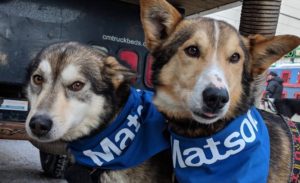 Individual dogs mature at different rates. Thus the two-year old class at SP Kennel has some very talented, well educated mature dogs. But there are also slow learners who haven’t quite grown into their bodies. For this reason, SP Kennel often enters a ‘JV’ (Junior Varsity) team in many of the races. These teams will be lead by several mature, knowledgeable dogs, but the bulk of the team will be youngsters. The pace and goal of the JV team is entirely different from that of a winning team – with education and positive experiences being the most important achievements. There are rare individuals in the two-year old class who supersede all expectations and join the main racing team.
Individual dogs mature at different rates. Thus the two-year old class at SP Kennel has some very talented, well educated mature dogs. But there are also slow learners who haven’t quite grown into their bodies. For this reason, SP Kennel often enters a ‘JV’ (Junior Varsity) team in many of the races. These teams will be lead by several mature, knowledgeable dogs, but the bulk of the team will be youngsters. The pace and goal of the JV team is entirely different from that of a winning team – with education and positive experiences being the most important achievements. There are rare individuals in the two-year old class who supersede all expectations and join the main racing team.
From three years until nine years of age, SP Kennel dogs are trained and conditioned for the main racing team. These dogs are experienced, knowledgeable, driven, and savvy. The smarter, more driven dogs, who understand their musher’s desires have usually taken the lead dog positions. At SP Kennel we try every dog as a lead dog and many will have some skills up front. During serious racing or hazardous situations the most skilled leaders will be positioned up front. In some situations it is best to have one leader in the front and one musher in the rear – with the lines of communication running both ways.
 Each year we retire select dogs from their SP Kennel racing careers. Our philosophy has always been and will always be: “the right home, for the right dog, at the right time”. We are never in a hurry to “move dogs” and they will stay here until the timing is correct for them to leave. Of course, some dogs will never leave. But, the fact is: “We only have one couch, and Allen has to fit on it too!” So we try to keep our retired dog population living indoors at SP Kennel to a maximum of six (or so).
Each year we retire select dogs from their SP Kennel racing careers. Our philosophy has always been and will always be: “the right home, for the right dog, at the right time”. We are never in a hurry to “move dogs” and they will stay here until the timing is correct for them to leave. Of course, some dogs will never leave. But, the fact is: “We only have one couch, and Allen has to fit on it too!” So we try to keep our retired dog population living indoors at SP Kennel to a maximum of six (or so).
It is with a mixed blessing to retire any SP Kennel dog. But the fact of the matter is that we are a competitive racing kennel. When we are truthful with ourselves (and with our fans), that fact needs to override the desire to keep every one of our awesome dogs and turn our kennel into an Alaskan Husky Fun House. Sounds “fun” but not real competitive, huh?
It is only because we spend a great deal of time finding the correct home for each retiree, that we are able to let these dogs go. It is very emotional when the perfect home comes along – both happy and sad!



